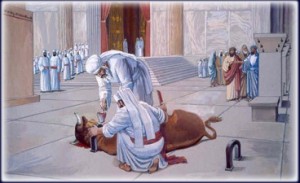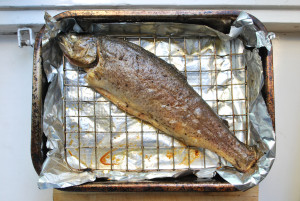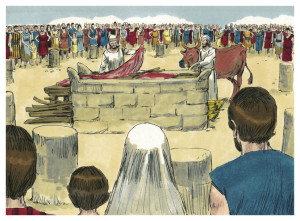 How taka do we, bazman hazeh (in our times), make amends with those whom we have hurt? With the RBSO? Stay tuned. Back when the Yiddin were in the desert where they would sojourn forty years, and just after they violated one of the Commandments by building and partying with the eygel hazohov (golden calf), the RBSO ordered and allowed them to build the Mishkan. Korbonos (sacrifices) were introduced; sinners had a way of making amends with the RBSO and with others whom they had aggrieved by bringing one or more of the animals designated as potential korbonos. The korban allowed one to atone for a healthy number of sins. They are prominently featured in this week’s parsha. A few others will appear next week. Shoin, humans sinned and poor unsuspecting animals were slaughtered. Not a bad deal; the RBSO is great. Alas, that Mishkan and others which followed, are long gone. And by long, we’re talking some 2000 years back. Korbonos too are gone. A gittin shabbis! Shoin, if only it were that easy, if only we were ordered to cut out the reading and studying regimens for mitzvos that are no longer relevant. It’s not!
How taka do we, bazman hazeh (in our times), make amends with those whom we have hurt? With the RBSO? Stay tuned. Back when the Yiddin were in the desert where they would sojourn forty years, and just after they violated one of the Commandments by building and partying with the eygel hazohov (golden calf), the RBSO ordered and allowed them to build the Mishkan. Korbonos (sacrifices) were introduced; sinners had a way of making amends with the RBSO and with others whom they had aggrieved by bringing one or more of the animals designated as potential korbonos. The korban allowed one to atone for a healthy number of sins. They are prominently featured in this week’s parsha. A few others will appear next week. Shoin, humans sinned and poor unsuspecting animals were slaughtered. Not a bad deal; the RBSO is great. Alas, that Mishkan and others which followed, are long gone. And by long, we’re talking some 2000 years back. Korbonos too are gone. A gittin shabbis! Shoin, if only it were that easy, if only we were ordered to cut out the reading and studying regimens for mitzvos that are no longer relevant. It’s not!
Welcome to Sefer and parshas Vayikra, it’s time to once again learn all about sacrifices. Why, ver veyst? Must we learn (yet again) about korbonos and the roughly 240 mitzvos associated with them, when they are no longer relevant in our times? Ver veyst? And why aren’t they relevant? Because korbonos, originally introduced en masse upon the completion of the Mishkan project (which we spent five weeks discussing), and then later, a hallmark of both Batei Mikdash (1st and 2nd Temples), disappeared following the destruction of the Second Temple. We are taught that the Second Temple was destroyed due to excessive ‘sinas chinam’ (petty jealousy among the people). Whatever the reason or reasons for the cessation of sacrifices, the untishter-shira (bottom line ) is azoy: Bazman hazeh (in our times), we do not offer animal sacrifices as a means of making amends with the RBSO and others we aggrieved.
 Perhaps they will make a comeback when the Moshiach arrives. Or, maybe not. Do any of you hear rumblings about the Moshiach arriving any time soon? Have the Yiddin cut out, or even back, on their loshoin horo or sinas chinam? Ha! Have they properly observed two consecutive shabosim without desecrating the holy day of rest? A nechtiger tug (not)! As an aside, the heylige Gemora (cannot recall where) and myriad medroshim, will teach us that were the Yiddin not to desecrate the heylige shabbis for two consecutive weeks, Moshiach would make an instant appearance. And he will stay. Speaking of keeping the heylige shabbis, let’s digress for a page or more to respond to a shaylo received to the Oisvorfer’s site from a reader by the name of Claire who wrote azoy:
Perhaps they will make a comeback when the Moshiach arrives. Or, maybe not. Do any of you hear rumblings about the Moshiach arriving any time soon? Have the Yiddin cut out, or even back, on their loshoin horo or sinas chinam? Ha! Have they properly observed two consecutive shabosim without desecrating the holy day of rest? A nechtiger tug (not)! As an aside, the heylige Gemora (cannot recall where) and myriad medroshim, will teach us that were the Yiddin not to desecrate the heylige shabbis for two consecutive weeks, Moshiach would make an instant appearance. And he will stay. Speaking of keeping the heylige shabbis, let’s digress for a page or more to respond to a shaylo received to the Oisvorfer’s site from a reader by the name of Claire who wrote azoy:
Hello rebbe
I have known my entire life that Shabbos begins sunset on Friday and that candle-lighting time on the calendar is about 18 minutes before sunset. But my entire life, no one could explain to me why that is. Why 18 minutes? Why not just at the precise shabbos time?
thank you in advance
Claire
Dear Claire:
So happens that the Oisvorfer was mamish dreading writing this week’s review and was giving serious consideration to repeating an older Vayikra posting. What more could be said about korbonos that wasn’t previously covered in the last five years? Shoin, along came your shaylo and mamish it was timely.
Nu, Claire asked a good question ober it has an answer. In fact it has many; no surprise there. And the answer is fish. Fish? Not just any fish but the answer to Claire’s question is, according to at least one source, related to a small fish being roasted. Nu, mistama your mother never explained this to you -who could blame her- ober believe it or not, one of the several reasons cited for adding 18 minutes to the shabbis by lighting candles before sunset, is taka fish related. Lommer lernin. Says the Shulchan Oruch (Code of Jewish Law) azoy: we are to “add from the weekday to the shabbis.” And he states this why, from what source and based on what? On a few words in the heylige Toirah which describe fasting on Yom Kippur. Shoin, case closed. We need to add some regular time to the shabbis and this addition is what we lovingly call ‘Toisfis Shabbis’ (adding to the shabbis). Moreover, according to many, maybe even most, adding minutes to the shabbis may in fact be a mitzvas d’oirayso (biblically commanded) and taka so says the heylige Gemora (Yoma 81b) and many other sources. Are you chapping all this? Veyter. And now the only sheylo is how much must one add to the shabbis? Is one minute enough, efsher two, or is any random number sufficient to fulfill the mitzvah of toisfis shabbis? Who introduced the concept of 18 minutes and why? Several reasons are offered ober not to confuse Claire too much, we will limit ourselves to but one.
 Citing the Ramban, whom we will cite again on a different topic a shtikel below, said the Maggid Mishneh (Hilchos Maacholas Asuros 6:10) azoy: Back in Talmudic times, it was the minhag to blow the shoifer (rams horn) six times (six blasts) before the shabbis. After the third blast, it was time to light the candles. And? Following the third blast, they would wait “the time it takes to roast a small fish” and when roasted, the shoifer would be blasted three more times. The last blast was the indication that shabbis was beginning and that all work needed to cease. Shoin, you must be klerring that the Oisvorfer has mamish lost his marbles, that there is something more than fishy about this answer and that this can’t be. Why? Because your mother never mentioned it, nor is this little known factoid written into any of the myriad calendars you are likely deluged with yearly during the months of August and September. Who knew one can use fish roasting as a time keeper to know when the shabbis begins? Very few people.
Citing the Ramban, whom we will cite again on a different topic a shtikel below, said the Maggid Mishneh (Hilchos Maacholas Asuros 6:10) azoy: Back in Talmudic times, it was the minhag to blow the shoifer (rams horn) six times (six blasts) before the shabbis. After the third blast, it was time to light the candles. And? Following the third blast, they would wait “the time it takes to roast a small fish” and when roasted, the shoifer would be blasted three more times. The last blast was the indication that shabbis was beginning and that all work needed to cease. Shoin, you must be klerring that the Oisvorfer has mamish lost his marbles, that there is something more than fishy about this answer and that this can’t be. Why? Because your mother never mentioned it, nor is this little known factoid written into any of the myriad calendars you are likely deluged with yearly during the months of August and September. Who knew one can use fish roasting as a time keeper to know when the shabbis begins? Very few people.
Anyway Claire, not to worry; others have easier to digest rationales for lighting the candles 18 minutes before the shabbis mamish begins though none quite as entertaining. As mentioned above, 18 minutes are not quite set in stone and in certain communities, limoshol (by way of example) over in Yirusholayim and over in Petach Tikveh of all places, the minhag is to light candles a full 40 minutes before shabbis really begins. Maybe the fish are larger there, ver veyst? One is avada adding to the shabbis by lighting the candles even one minute earlier, ober, over time, the 18 minute marker has been more generally accepted. Grada the Oisvorfer has come across at least 19 different sources for this custom or law. Those for another day. Thank you for following the Oisvorfer.
Shoin, let’s get back to sin atonement absent the ability to offer sacrifices. And how does one taka kiss and make up with his eishes chayil once he has mamish upset her? In our times, if we sin against our wives and who doesn’t, we first say “I’m sorry” and when that doesn’t work or isn’t enough (depending avada how great the sin was), we buy them jewelry. Typically, though not always, that does work. Grada buying jewelry for the eishes chayil has other benefits, if you chap. One thing is certain: Without one or the other, and typically both, one is not chapping. Also, as a result of technological advances, saying I’m sorry to the eishes chayil is not as difficult as it once was. In hyntige tzeytin (in modern times), we can mostly say I’m sorry, I did wrong, and other such expressions of remorse, via our smart phones. We can What’s App, instant message, send an old fashioned text, and even make use of email. We can add emojis to express regret and more. A shtikel less personal but seemingly also effective. Grada these newer methods of saying ‘I’m sorry’ have become more popular among feuding friends who are balydikt (insulted), pissed off mamish, over something you said or did. Boundless examples come to mind. It also works farkert: those that pissed you off can avail themselves of the very same technology. This method of saying I’m sorry allows one to test the waters. The sender writes a few words of apology that he/she would not in the ordinary course wish to state in person. The recipient looks at the response over and again, until the recipient’s heart warms a bit and is receptive to the apology. Shoin: no animal was sacrificed, the people at PETA and other animal rights groups are not protesting, and a friendship is sometime preserved. Why a few rabbis keep insisting that the Internet is treif and don’t want their chassidim using smart phones, ver veyst?
 Does this work with the RBSO? Mistama not! Back in the days of the Mishkan and also the Temples which followed, korbonos were the mainstay and focal point of the entire structure. It was the place to come to for forgiveness and atonement. The RBSO accepted that people were shlecht (bad), and that people made mistakes many and often. Sinning was accepted as normative human behavior. It was the place to seek absolution, to start over again. Sinners arrived daily, followed the hands-on procedures, paid off the Koihen to cut the line, shared some of the offerings with the koihen (from certain offerings) and at the end of the day, everyone was happy. Sacrificing was a feel good experience. Ober, korbonos have been replaced with davening and with the study of how korbonos used to work. Moreover, the RBSO did give us Yom Kippur as a day of atonement and does accept apologies every day of the year.
Does this work with the RBSO? Mistama not! Back in the days of the Mishkan and also the Temples which followed, korbonos were the mainstay and focal point of the entire structure. It was the place to come to for forgiveness and atonement. The RBSO accepted that people were shlecht (bad), and that people made mistakes many and often. Sinning was accepted as normative human behavior. It was the place to seek absolution, to start over again. Sinners arrived daily, followed the hands-on procedures, paid off the Koihen to cut the line, shared some of the offerings with the koihen (from certain offerings) and at the end of the day, everyone was happy. Sacrificing was a feel good experience. Ober, korbonos have been replaced with davening and with the study of how korbonos used to work. Moreover, the RBSO did give us Yom Kippur as a day of atonement and does accept apologies every day of the year.
Are korbonos slated for a comeback? As stated above, we mamish don’t know. Why not? Because the RBSO did not tell us. Nor did He tell us why He introduced korbonos. That avada led to speculation by many ober the emes is we don’t know. That being said, because the RBSO taught them to Moishe and he to us, it’s our job to study them and it’s time for a quick chazoro. After all, says the heylige Gemora (I cannot recall where), azoy: a person forgets what he learned within 12 months. Hence our rabbis argue, we must continue learning regularly and often, in order not to forget. Grada, as we mentioned just last week, a number of people forget things even before 12 months, especially those who owe you a favor, money, or anything else they are not comfortable remembering and of course repaying. Shoin, if you want a more in depth review of korbonos and why we bring them, what they represent, along with some humor and sarcasm, please click here www.oisvorfer.com where you will find a few givaldige insights into this topic.
And before we close with a very brief argument between the RambaM and the Ramban over why the RBSO ordered that we bring korbonos, don’t you already miss terribly a number of colorful characters we met back in Bereishis and Shemois? Of course! Weren’t you amazed to learn that Lemach whom we met over in parshas Bereishis had two wives? And weren’t you a shtikel envious to learn that one was for childbearing and the other strictly for tashmish (sex toy)? Avada you were and mistama you were thinking azoy: if only we were back in biblical times. And weren’t you amazed to learn that Loit had his way with and impregnated both his daughters? And that the children born to his girls gave birth to the nations we will be reading about in the coming months? Avada you were! There were so many more; each story was amazing. And weren’t you quite nervous when you read that the RBSO eliminated both Eyr and Oinon because He did not like them. In fact, the heylige Toirah tells us that He found them repugnant. And why? Shoin, Rashi and others will tell us it was because they wasted seed. How lucky are you that you have been sliding by unscathed? Shoin! It will be a few weeks and maybe even months before we get back to givaldige storylines we can relate to.
The good news: Not all of sefer Vayikro concerns itself with animals sacrifices. Grada we will meet and say good bye to a few colorful characters including the wood gatherer, the blasphemer and others that enraged the RBSO. Alas, we will have to wait a few weeks and muddle our way through the first few weeks of Vayikra which will in painstaking detail describe every detail of every korban. The bottom line: It epes appears that the RBSO gave us korbonos for several reasons. Which one? Ver veyst and depends avada on whose pshat talks to you.
 Said the Rambam: korbonos were given because the Yiddin were still used to the pagan ways they had practiced while enslaved and before Matan Toirah (Revelation). These included animal sacrifices. Shoin: the RBSO chapped that the Yiddin, still mentally a broken people, could not go cold turkey, that pagan rituals which included sacrificing animals was mamish part of their being. They were not quite ready to let go and needed to be slowly weaned off. Shoin: He allowed sacrifices but attached spirituality to them. He made them ritually kosher and meaningful. Moreover, when brought, they would forgive certain sins and transgressions. Which sins? Shoin, that too depends on whom you ask.
Said the Rambam: korbonos were given because the Yiddin were still used to the pagan ways they had practiced while enslaved and before Matan Toirah (Revelation). These included animal sacrifices. Shoin: the RBSO chapped that the Yiddin, still mentally a broken people, could not go cold turkey, that pagan rituals which included sacrificing animals was mamish part of their being. They were not quite ready to let go and needed to be slowly weaned off. Shoin: He allowed sacrifices but attached spirituality to them. He made them ritually kosher and meaningful. Moreover, when brought, they would forgive certain sins and transgressions. Which sins? Shoin, that too depends on whom you ask.
Ober said the Ramban azoy: it is illogical to believe that the RBSO ordered korbonos in order to allow the Yiddin to slowly wean themselves off their past pagan rituals. We were already introduced to holy and well intended korbonos way back in parshas Bereishis and in many other parshas since. Didn’t both Kayin and Hevel bring sacrifices? Shoin, we know what happened next. And didn’t Noiach, following his harrowing boat ride, build an altar to the RBSO on which he offered a sacrifice to the RBSO? He did! Shoin, we know what happened to him next as well. And didn’t our forefathers offer sacrifices to the RBSO as a means of saying thank you and or entering into covenants? They did! In other words: sacrifices to the RBSO were not rooted in pagan practice. And there must be a more logical explanation as to why the RBSO ordered and allowed for a series of sacrifices.
Says the Ibn Ezra so gishmak azoy: Humans function on three levels: thought, speech, and action. And they sin using all three of those functions. The RBSO gave instructions for sinners to bring a korban. A sinner could achieve atonement through sacrificing one of the approved animals. The heylige Toirah will teach us that the sinner must place his hands on the animal. The placing of the hands represents any improper actions that the hands had been involved with, if you chap while committing the sin. Shoin, no need to elaborate, you all chap. And if you chap, more than likely you also used your hands. Next, the sinner needed to utter words of confession and these spoken words were meant to correspond to any improper words he had spoken while committing the sin. Again, many of you are guilty as charged. Finally, the internal organs of the animal, corresponding to the organs whence thought and cravings originate, needed to be consumed by the fire of the altar to remind the sinner that it was really he that was deserving of death by fire. That his own blood and organs should have been spilt as punishment for transgressing the word of the RBSO. Ober the RBSO in His magnificence and benevolence, decided to allow mankind to magically transfer his misdeeds and to sacrifice the animal instead. Boruch Hashem!
The bottom line: we should be more than thankful for the opportunity to bring such sacrifices and should taka be learning parshas Vayikra and next week’s parsha of Tzav to become familiar with each korban and how we can, in today’s times, in lieu of korbanos, find ways of asking the RBSO to forgive our sins and let us live to see another day. We need it!
A gittin Shabbis-
The Oisvorfer Ruv
Yitz Grossman
